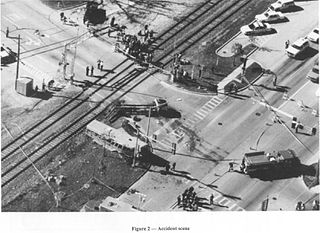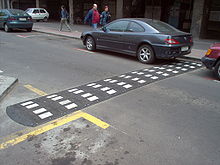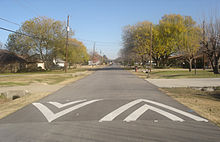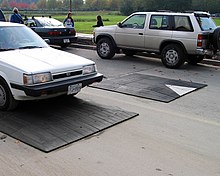
Traffic comprises pedestrians, vehicles, ridden or herded animals, trains, and other conveyances that use public ways (roads/sidewalks) for travel and transportation.

A roundabout, a rotary and a traffic circle are all, with certain distinctions between them, a type of circular intersection or junction in which road traffic is permitted to flow in one direction around a central island, and priority is typically given to traffic already in the junction.

Traffic calming uses physical design and other measures to improve safety for motorists, car drivers, pedestrians and cyclists. It has become a tool to combat speeding and other unsafe behaviours of drivers in the neighbourhoods. It aims to encourage safer, more responsible driving and potentially reduce traffic flow. Urban planners and traffic engineers have many strategies for traffic calming, including narrowed roads and speed humps. Such measures are common in Australia and Europe, but less so in North America. Traffic calming is a calque of the German word Verkehrsberuhigung – the term's first published use in English was in 1985 by Carmen Hass-Klau.

Road traffic safety refers to the methods and measures used to prevent road users from being killed or seriously injured. Typical road users include pedestrians, cyclists, motorists, vehicle passengers, and passengers of on-road public transport.
A chicane is a serpentine curve in a road, added by design rather than dictated by geography. Chicanes add extra turns and are used both in motor racing and on roads and streets to slow traffic for safety. For example, one form of chicane is a short, shallow S-shaped turn that requires the driver to turn slightly left and then slightly right to continue on the road, requiring the driver to reduce speed. The word chicane is derived from the French verb chicaner, which means "to create difficulties" or "to dispute pointlessly", "quibble", which is also the root of the English noun chicanery. The Spanish verb chicanear also means "to use trickery".

A curb extension is a traffic calming measure which widens the sidewalk for a short distance. This reduces the crossing distance and allows pedestrians and drivers to see each other when parked vehicles would otherwise block visibility. The practice of banning car parking near intersections is referred to as daylighting the intersection.

In road transport, a lane is part of a roadway that is designated to be used by a single line of vehicles to control and guide drivers and reduce traffic conflicts. Most public roads (highways) have at least two lanes, one for traffic in each direction, separated by lane markings. On multilane roadways and busier two-lane roads, lanes are designated with road surface markings. Major highways often have two multi-lane roadways separated by a median.

An emergency vehicle is a vehicle used by emergency services. Emergency vehicles typically have specialized emergency lighting and vehicle equipment that allow emergency services to reach calls for service in a timely manner, transport equipment and resources, or perform their tasks efficiently. Emergency vehicles are usually operated by authorized government agencies, but some may also be operated by private entities where permitted by law.

The 1995 Fox River Grove bus–train collision was a grade crossing collision that killed seven students riding aboard a school bus in Fox River Grove, Illinois, on the morning of October 25, 1995. The school bus, driven by a substitute driver, was stopped at a traffic light with the rearmost portion extending onto a portion of the railroad tracks when it was struck by a Metra Union Pacific Northwest Line train en route to Chicago.

Road signs in the United Kingdom and in its associated Crown dependencies and overseas territories conform broadly to European design norms, though a number of signs are unique: direction signs omit European route numbers, and road signs generally use the imperial system of units, unlike the rest of Europe. Signs in Wales and parts of Scotland are bilingual.
Traffic signal preemption is a system that allows an operator to override the normal operation of traffic lights. The most common use of these systems manipulates traffic signals in the path of an emergency vehicle, halting conflicting traffic and allowing the emergency vehicle right-of-way, thereby reducing response times and enhancing traffic safety. Signal preemption can also be used on tram, light-rail and bus rapid transit systems, to allow public transportation priority access through intersections, and by railroad systems at crossings to prevent collisions.

In traffic engineering, there are regional and national variations in traffic light operation. This may be in the standard traffic light sequence or by the use of special signals.

Road signs in Norway are regulated by the Norwegian Public Roads Administration, Statens vegvesen in conformity with the 1968 Vienna Convention on Road Signs and Signals, to which Norway is a signatory.

Road signs in Iceland are visual communication devices placed along roads and highways throughout the country to provide information, warnings, and guidance to motorists and pedestrians. Iceland never ratified the Vienna Convention on Road Signs and Signals, but road signs in Iceland conform to the general pattern of those used in most other European countries, with certain design elements borrowed from Danish and Swedish practice. Signs tend to be more sparsely employed than in other European countries, especially in rural areas.
Driving in the United Kingdom is governed by various legal powers and in some cases is subject to the passing of a driving test. The government produces a Highway Code that details the requirements for all road users, including drivers. Unlike most other countries in the world, UK traffic drives on the left.

A radar speed sign or speed feedback sign is an interactive sign comprising a speed-measuring device and a message sign generally constructed of a series of LEDs, which displays vehicle speed of approaching motorists. The purpose of radar speed signs is to slow cars down by making drivers aware when they are driving at speeds above the posted limits. They are used as a traffic calming device in addition to or instead of physical devices such as speed bumps and rumble strips.

The geometric design of roads is the branch of highway engineering concerned with the positioning of the physical elements of the roadway according to standards and constraints. The basic objectives in geometric design are to optimize efficiency and safety while minimizing cost and environmental damage. Geometric design also affects an emerging fifth objective called "livability," which is defined as designing roads to foster broader community goals, including providing access to employment, schools, businesses and residences, accommodate a range of travel modes such as walking, bicycling, transit, and automobiles, and minimizing fuel use, emissions and environmental damage.

Speed limits in the Philippines are specified in Republic Act No. 4136, or the Land Transportation and Traffic Code of the Philippines, which took effect on its approval on June 20, 1964. The act covers a number of areas other areas than speed limits, and was amended regarding some of those areas by Republic Act No. 10930, which was approved on August 2, 2017.

Terminology related to road transport—the transport of passengers or goods on paved routes between places—is diverse, with variation between dialects of English. There may also be regional differences within a single country, and some terms differ based on the side of the road traffic drives on. This glossary is an alphabetical listing of road transport terms.

Road signs in South Africa are based on the SADC-Road Traffic Sign Manual, a document designed to harmonise traffic signs in member states of the Southern Africa Development Community. Most of these signs were in the preceding South African RTSM.






















